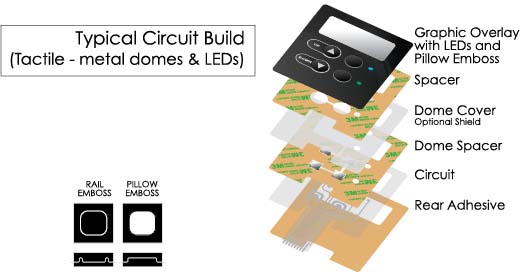How Membrane Switch Technology is Revolutionizing User Interfaces
How Membrane Switch Technology is Revolutionizing User Interfaces
Blog Article
Comprehending Membrane Layer Changes: The Key to Reputable and long lasting Controls

What Are Membrane Layer Switches?
Membrane layer buttons are a sophisticated service in the world of interface innovation, integrating performance and design effortlessly. These tools offer as an interface between users and digital systems, incorporating several parts right into a portable layout. Generally constructed from flexible, thin layers of materials, membrane layer buttons are developed to react to touch, making it possible for customers to communicate with equipment and digital tools effectively.
The key aspects of a membrane button consist of a published circuit layer, graphic overlay, and a spacer layer that prevents unexpected activation. The visuals overlay can be customized to mirror brand identity or user preferences, boosting visual appeals while making sure use. Membrane switches are frequently used in numerous applications, including clinical gadgets, consumer electronic devices, and industrial devices, owing to their durability and resistance to ecological factors such as moisture and dust.
One of the crucial advantages of membrane layer buttons is their capacity to stand up to deterioration, making them suitable for high-traffic environments. In addition, they are light-weight and call for marginal area, permitting for cutting-edge layouts in item advancement. Overall, membrane switches over represent a useful and efficient selection for modern-day digital interfaces, marrying technology with user-centric design principles.
Just How Membrane Layer Switches Over Job
The operation of membrane switches over hinges on a straightforward yet efficient mechanism that converts user input into digital signals. These switches consist of multiple layers, generally consisting of a graphic overlay, a spacer layer, and a circuit layer. When a customer presses the button, the leading layer flaws, allowing a conductive element in the circuit layer to reach a matching conductive pad on the underside of the visuals overlay. This call shuts the circuit and sends out a digital signal to the device, indicating that the button has been activated.
The layout of membrane layer switches can vary, but they frequently integrate domes or tactile components to supply comments to the user, improving the general experience - membrane switch. The materials utilized in membrane buttons, such as polyester or polycarbonate, contribute to their sturdiness and resistance to environmental variables, consisting of wetness and dirt. The published circuits are generally enveloped, which safeguards them from wear and tear over time.
Benefits of Membrane Layer Buttons

Additionally, membrane buttons are recognized for you can find out more their resilience. Constructed from robust materials, they are resistant to dust, dampness, and physical wear, which considerably expands their life expectancy compared to typical mechanical switches. This sturdiness makes them especially appropriate for high-traffic settings and applications requiring durability.
One more substantial advantage is the simplicity of cleansing and upkeep. The smooth surface area of membrane layer switches minimizes dust buildup and is usually unsusceptible spills, making them suitable for setups that need frequent sanitization.
Moreover, membrane buttons supply a structured account, causing a thinner design that can be integrated right into different tools without adding mass. This attribute not only improves the aesthetic charm however also adds to an extra ergonomic item layout.
Applications of Membrane Switches
User-friendly and functional, membrane layer switches discover applications throughout a vast array of industries, consisting of medical tools, consumer electronic devices, and look at this web-site commercial equipment. In the clinical field, these switches are integral to devices such as analysis devices, person tracking systems, and infusion pumps, where dependability and simplicity of cleansing are essential. Their capability to keep and hold up against harsh settings performance makes them optimal for such applications.

In customer electronic devices, membrane layer buttons are made use of in items like microwaves, washing machines, and remote controls - membrane switch. Their sleek style permits intuitive customer interfaces, improving the general user experience while giving sturdiness and resistance to put on and tear
Commercial devices also takes advantage of membrane switches, particularly in control panels for equipment and automation systems. These buttons provide defense against dirt and moisture, making certain constant efficiency in tough environments. Their customizable features permit manufacturers to tailor them to details operational requirements, enhancing efficiency and performance.
Choosing the Right Membrane Switch
When selecting a membrane button, it is necessary to think about different aspects that affect efficiency and suitability for specific applications. The primary helpful hints considerations consist of environmental conditions, responsive comments, toughness, and design specs.
First, analyze the operating environment; buttons exposed to wetness, chemicals, or extreme temperatures require certain products to ensure longevity and performance. Next, review the need for tactile feedback. Depending upon customer interaction, some applications might take advantage of a responsive reaction to validate activation, while others might like a non-tactile layout for aesthetic factors.
Sturdiness is an additional critical element; membrane buttons need to be created to stand up to regular use, influences, and abrasion. Make certain the picked switch can endure the anticipated lifecycle, specifically in high-usage circumstances.

Final Thought
In conclusion, membrane changes offer as crucial parts in the design of trustworthy and sturdy control systems across different markets. The convenience of membrane switches allows for customized options that meet specific functional requirements, enhancing their value in modern-day innovation.
Membrane changes represent an important element of modern-day user interface layout, mixing capability with durability in numerous applications.Membrane buttons are an innovative remedy in the realm of customer interface modern technology, combining functionality and design flawlessly. Normally constructed from versatile, slim layers of products, membrane switches are created to respond to touch, allowing customers to engage with equipment and digital tools successfully.
The style of membrane layer switches can vary, but they commonly include domes or responsive elements to supply responses to the user, improving the total experience.In verdict, membrane layer switches over serve as vital elements in the design of durable and trustworthy control systems across numerous sectors.
Report this page